|
FAQs about Fungiid Coral Identification
Related Articles: Fungiid
Corals,
Related FAQs:
Fungiid Corals 1,
Fungiid Corals 2,
Fungiid Behavior, Fungiid Compatibility, Fungiid Selection, Fungiid Systems, Fungiid Feeding, Fungiid Disease, Fungiid Reproduction, Stony/True Coral, Coral System Set-Up, Coral System Lighting, Stony Coral Identification, Stony Coral Selection, Coral Placement, Foods/Feeding/Nutrition, Disease/Health, Propagation, Growing Reef Corals, Stony Coral Behavior,
|
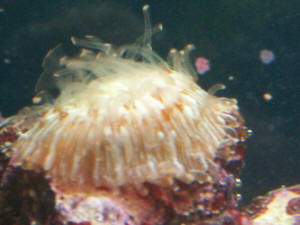
|
http://dpc.uba.uva.nl/cgi/t/text/get-pdf?c=ctz%3Bidno%3D8002a02 A
molecularly based phylogeny reconstruction of mushroom corals
(Scleractinia: Fungiidae) with taxonomic consequences and evolutionary
implications for life history traits
|
Encrusting LPS "Lithophyllon" ID
1/17/16
Hi Crew!
<Dani!>
If you would be so kind, please confirm that this coral at my LFS is actually
"kiwi Lithophyllon". They claim it is an encrusting LPS.
<Mmm; encrusting or laminating....>
From what I researched, it is pretty rare and there is very little info on the
internet about caring for it. They have it on the bottom shelf and don't target
feed it--don't most healthy LPS readily welcome target feedings?
<Mmm; well; IF there's sufficient chemical and particulate foods in the water;
target feeding isn't necessary; and can lead to eutrophication>
The Lithophyllon I found on your site appears to reference a plate coral?
On the net I found some called Lithophyllon undulatum, looks more like that.
<Yes; this is the more common species of this genus that I've run across... more
so than L. mokai, others>
I just want to ensure I am getting what I paid for, moreover I can take care of
it properly! Thank you for any advice on its care!
Dani :)
<Bob Fenner>
|
.JPG)
.JPG) |
|
Galaxea, and mystery Cnidarian
Crew,
<SP>
I first and foremost would like to thank you for the informative
website, and at first I have some good news. I
took in a small Galaxea colony that had
completely bleached about nine days ago, it was completely transparent
except for a few tentacles with had faint green color. Since then
here is the color I have seen develop, it also
was not exhibiting polyp extension in the old
tank. I am frequently surprised at how resilient coral can be.
Anyway, nearly a year ago I emailed about a strange species that
appeared in my fish tank attached to a Favites
colony I purchased. I thought it was
likely Euphyllia of some sort, but it has
exhibited non-Euphylliid behavior
I am fairly certain. It underwent rapid division (started with two
separate individuals and now have over 15 all
differ in size largest is about 3.5 inches) It
had tissue that was attached to the rock, but after the skeleton
reaches about an inch in diameter it somehow
detaches from the rock
(including the skeleton) I know I must sound
crazy, but the colony also is growing
in diameter, but not especially in height. I have had Euphyllia
before, and never seen this kind of growth. I will attach the current
picture as well as the original I sent in and if more are needed
let me
know because Im not sure what this is. In hopes all is well,
Bryce
<Might be Euphyllia; perhaps acanthocauli... from a Fungiid: Heliofungia.
Bob Fenner>
|
.JPG)
.jpg)
.JPG) |
Re: Galaxea, and mystery Cnidarian
Would a picture with retracted tissue, and more skeleton be more helpful?
<If it was a close up and well-resolved, yes. BobF> |
Leaf Plate Coral? – 6/6/12
Dear crew / Bob,
<Dave>
It has been many years since requesting your help, firstly because I
spent time away from the hobby after re-locating from Shanghai to sunny
Ohio, and secondly due to the vast on-line archives help which is too
often over-looked I am sure.
<Ah yes>
However on this occasion I could not find any reference to the problem;
or even definitively identify the coral or issue in question. I
presently have a 16 month old 75g with 10g sump partitioned with 4" deep
live sand and Chaetomorpha, Aqua Medic T1000 skimmer, (2) rotating bags
weekly of ½ cup carbon, main tank has (2) 150w MH 14,000K bulbs, 216w T5
actinic mix, 90lb live rock. Conditions are PH 8.0 to 8.2, Salinity
1.025, Phosphate <0.1ppm, Nitrate <5ppm, Calcium 395, MeqL 4. I do
a 20% water change weekly and have had better than my Shanghai
experience success with a healthy tank stocked with mainly LPS corals,
(2) healthy clams, Regal and Yellow Tang, (2) Allen's Damsels, (2)
Banggai Cardinals, Flame Angel (No clam issues), Orange Stripe Prawn
Goby. Now to the issue, I saw
in my LFS just South of Toledo the attached pictured 'thing.' The LFS
owner who is actually very knowledgeable and helpful could not confirm
what type of coral this was, and stated that even his supplier said that
he has only seen this very
occasionally but also could not confirm what the coral actually was. I
went home and searched on-line and found only 'similar' comparisons to
what it looks like.
The closest match I thought was possibly a Montipora, but even that did
not seem to form the same shape or surface structure of the coral in
question. So my first question would be to ask if you have seen this
type of 'plate coral'
before and if so; could you direct me to the resource information about
it?
<Mmm, pretty sure this is a Fungiid of the genus Diaseris:
http://www.wetwebmedia.com/fungiidae.htm
Secondly to the issue, I of course purchased the item because am
fascinated with the different things we come across within the hobby;
and it had been at the LFS for a few weeks with lots of interest but no
takers, mainly as it was not
exactly cheap. However, I thought that I would have a decent chance with
the set-up I have, i.e. parameter control and lighting. After discussion
with the LFS owner we thought that a mid-tank position would be the
suitable approach to
take thinking that this would be a light dependent coral, but not
necessarily intense lighting requirements. So I acclimated for (2) weeks
lower in the tank to start with and then moved it up to a central
location. The problem now, and was apparent in the bottom of the tank
also before movement, seems to be that the green 'lines' on the coral
are coming away from the base skeleton leaving blotchy areas of the
structure. Any assistance with the identification and subsequent
requirements would be greatly appreciated before I lose the coral
completely.
<I'd "kick up" your dosing of iodide/ate and not move these>
As always, thanks for your continuous dedication and support.
Thanks
Dave
Best regards
<And you, Bob Fenner>
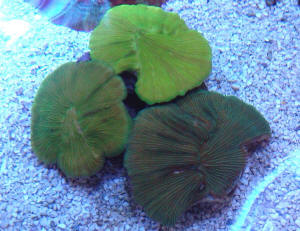 |
|
Can you id this for me please
3/18/12
Hi I was wondering if u can help me
http://i1113.photobucket.com/albums/k514/Falat1/DSCN0057.jpg
I got this on a colony of Zoas about 6 months ago it was about
3/4 of an inch now it's grown a bit to this
http://i1113.photobucket.com/albums/k514/Falat1/RSCN0232.jpg
it's now about 1 n half inch if disturbed it puffs up looks
like it inflates with water
thanks in advance
Regards
Gary
<Appears to be a (very lovely) Fungiid; a mushroom coral. Bob
Fenner>
|
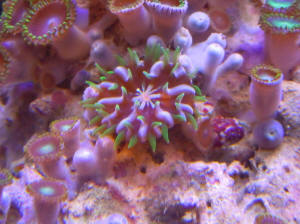 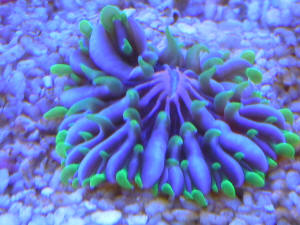 |
Re: Can you id this for me
please 3/18/12
Thank you for that some people were trying to say it was a Majano
or ball nem I appreciate the reply thanks again
Regards
Gary
<Ahh! Welcome. BobF> |
|
Fungiid Coral ID 5/13/10
Dear Crew,
<Henk>
Is it possible to give an ID for this Fungiid coral I purchased
today?
<Appears to be Fungia repanda.>
I am wondering because I read that Fungia Fungites is better
placed on the rock or hard substrate (contrary to other Fungiid
corals), and because I have seen several pictures of similar
looking corals labeled as Fungia
Fungites. So basically my question concerns the placement of this
coral...on the sand or on a flat rock?
<These corals should always be placed on a sand bottom, no
gravel. Placing on rock or gravel surfaces can be fatal as tissue
abrasion can occur through normal polyp cycling.>
As you can see from the picture, the previous owner put it on a
gravel substrate. Furthermore, is this a partially bleached
specimen or is this a natural coloration?
<Coral appears fine to me, feeding tentacles are extended,
etc. May want to read/learn more here.
http://www.wetwebmedia.com/fungiidae.htm>
Many thanks!
<You're welcome. James (Salty Dog)>
Regards,
Henk Naert
|
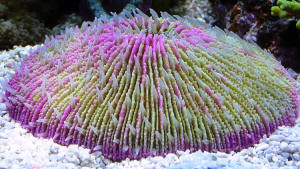 |
|
Can You Please ID This? Fungiid 2/4/2010
There has been an interesting debate on a forum site that I
belong to as to what this coral actually is. Here is the
background on this guy... It popped up off of a Zoanthid rock
colony, there are only 2 of them that popped
up. They are VERY colorful, (one having a pinkish/purple color
body with a bright pink mouth, and short BRIGHT green
"tentacle" type things, the smaller other remained
green bodied). They appear to have a skeletal structure
that they retract into when disturbed (see picture). They eat
Mysis, and brine shrimp when spot fed. They are both growing
bigger and bigger. The Zoanthids that they are living on/amongst
are growing and multiplying like crazy,
and seem to be flourishing constantly. I have heard everything
from majano anemone,
<No.>
to a Fungia plate coral..
<Yes.>
in my opinion it appears to look more like a plate coral than an
anemone (from pictures on the web, and from it
appearing to have a skeleton)..
<Yes, I am in agreement here. If there is skeleton, it is not
an anemone.>
but someone said that you would be able to give a definite
answer.
<My vote is for a Fungiid.>
Please let me know ASAP because it is driving me crazy!
:)
If you need more pictures just let me know, I have TONS!
<I think it is clear from the photos you've sent, it is a
Fungiid.>
-Kevin B
Tallahassee, FL
<Mich L
Gouldsboro, PA><<Well done Mich. B>>
|
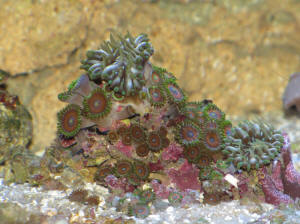 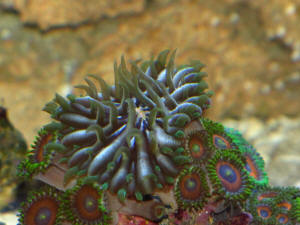 |
Please ID this Hi, all. I have searched endlessly on
your site and can find nothing resembling what I have on a piece of
rock in my soft coral tank. First off, This came on a piece of rock
that had some mushrooms on it about mid March. These two creatures
you see were hardly noticeable when i brought the Shrooms home. I
did see it, however and cut the rock to have this as a separate
specimen. <Good move> The larger of the two was about the
size of a small Zoa when I noticed it. The other was hardly able to
be seen. There are a total of 5 of these on the rock and they seem
to be localized on this small piece. They do not have a mat and are
not connected. <A good clue> The largest one that you see is
about the size of a penny, now and the other is catching up. They
remain open like you see them almost all the time and will catch
mysis to eat. I have seen no sweeper tentacles and they have not
physically moved themselves. I feel like I can rule out anemones.
There is no hard skeleton that I can see, either. <Mmm, I do>
Can you help? <Likely these recruits are Fungiids:
http://wetwebmedia.com/fungiidae.htm perhaps Cycloseris sp.>
Thank you
Jason
<Thank you for sharing, Bob Fenner> |
|
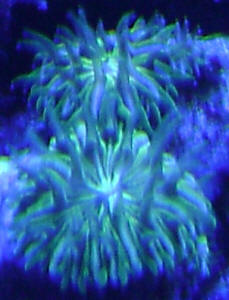
|
Odd plate coral -03/25/08 Dear Crew at WWM- I
have a quick question about my short tentacle plate coral (Fungia).
I have searched for pictures of plate coral that resembles mine. I
have 3 (one which grew as a bud) they all have extremely long
tentacles that sometimes stretch out 2 inches and are very fat. The
only pictures I find of plates have very short tentacles. I
don't think they are long tentacle plates because of the shape.
I have attached a picture, let me know what you think? <In my
opinion, it looks like a very healthy Fungia sp. coral to me.
"Short tentacle" plate corals you see in the
hobby/captivity are usually not in ideal health, thus their
tentacles probably aren't as long/extended as they might be
under ideal conditions. Or, you just have a species with longer
tentacles. Either way, no, I don't think it's a Heliofungia
sp., if that's what you're asking. :-)> Lmecher : )
<Best,
Sara M.> |
|
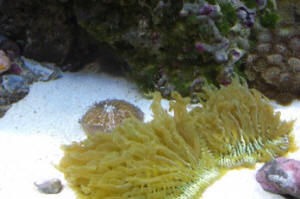
|
Can you ID this coral? Fungia 4/9/07 It was a
hitchhiker <A nice gift.> and looks to be a young Fungia,
<I would agree. More here for your edification: http://www.wetwebmedia.com/fungiidae.htm > When I first
found it growing on a the side of a zoo rock it was smaller then a
dime, <Tiny!> I glued it to its own rock so it would get
better lighting. <OK.> It is now the size of a quarter
<It's happy!> and if it's a Fungia I don't think
gluing it was such a good idea. <Mmm, no probably not.> Can
you help ID it <Your ID is correct.> and what should I do,
try to unglue it? <No, I would leave well enough alone. It is
growing/thriving. The Fungia's ability to move serves it well
in its natural environment, but is less essential in an aquarium
setting.> Thanks, Diane
<Welcome, Mich> |
|

|
| Plate coral trouble... ID, health bad news 7/12/05 Hello
crew, I hope that you can help me identify this coral as either
Heliofungia or simply a Fungia. It is seven inches wide, 18 inches
from 356 watts of VHO lighting, resting on the sandbed. It seems
that a turbo snail or possibly even a blue legged hermit crab has
ripped a hole in him. I have given him an iodine dip and tried
feeding him DT's live phytoplankton and minced shrimp and
scallops. Its mucus has caught the food up, but has yet to swallow
it. Any help is appreciated. Thanks. <Take a look: http://www.wetwebmedia.com/fungiidae.htm and the linked
files at top... almost certainly a Heliofungia. Bob Fenner> |
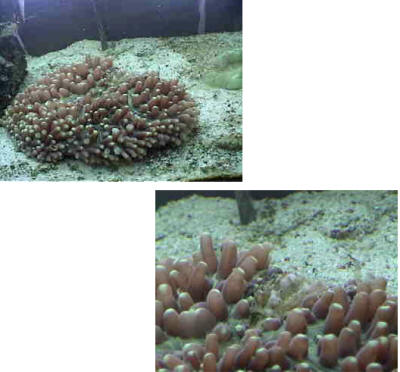
|
- Plate Coral Squirtin' Out Stuff -
Hello, This is my 10th day with a plate coral. It was doing fine in the
pet shop. After the third day in my house it has excreted out a white
substance. <Maybe just poo?> The tentacles are often retracted,
which I understand to be either unhappiness or a sign of sickness. Can
you please help me understand what is going on? I have gone on the
Internet, read referenced several books, consulted with various pet
representatives. We do not have a good answer. <Well, a "plate
coral" is usually one of two things; a Heliofungia or a Fungia.
Heliofungia sp. have long tentacles and do very poorly in captivity,
usually due to damage and subsequent infection. Fungia have short
tentacles and are pretty bullet proof. Please identify this critter so
I can give you a better answer; Aquarium Corals by Borneman or Corals:
a quick reference guide by sprung are quick and easy references for an
easy ID such as this. -Kevin> Thanks for your help.
|
|

